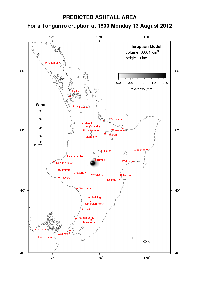
Volcanic Activity Bulletin TON-2012/18 - Tongariro Volcano
Volcanic activity remains low. There has been no significant seismic activity at Tongariro for several days. Heavy rain on Sunday produced minor lahars which affected State Highway 46.
No further reports have been received since Sunday. Of the three eruption scenarios deemed possible over the next seven days, the scenario considered most likely is that there will be no further eruptions, the next likely is that any eruptive activity will be of similar magnitude to that on August 6, and the least likely that larger eruptions will occur.
Seismic activity at Tongariro has remained low since the 6 August eruption. No ground deformation originating in the Tongariro area has been observed. Recent poor weather has prevented visual observations.
Scientists have considered three eruption scenarios deemed possible over the next seven days and have evaluated these based on monitoring data, historic activity at Tongariro, and experience of New Zealand and overseas eruptions. Over the next seven days the scenario considered most likely is that there will be no further eruptions. The next most likely scenario is that any eruptions will be of similar size to the eruption on 6 August. The scenario considered least likely is that larger eruptions will occur. This assessment is valid for only the next seven days and a change in monitoring parameters may change the assessment.
On Sunday heavy rain remobilised some ash erupted on 6 August and a minor lahar crossed State Highway 46 at the northern foot of Tongariro. No further reports of lahar flows have been received since Sunday.
Some concerns remain over the debris flow formed by the 6 August eruption that is blocking two small streams draining the northern slopes of Tongariro and the potential this has to produce larger lahars. A process is in place to start to assess this threat.
Analyses of volcanic gases from airborne measurements last Thursday have been completed and showed 3,900 tonnes per day of carbon dioxide (CO2) and 364 tonnes per day of hydrogen sulphide (H2S) gas, in addition to the 2,100 tonnes per day of sulphur dioxide (SO2) reported previously. These gases confirm the presence of magma beneath the volcano, but do not give any indication about its depth or volume.
The smell of hydrogen sulphide (H2S) gas was reported from several localities south of Tongariro over the weekend. High hydrogen sulphide (H2S) gas levels have been observed in the volcanic plume, and may potentially cause some discomfort for those with breathing difficulties. The areas affected will always be downwind of the volcano, and may change daily.
Several days of microscopic and geochemical analysis of the widespread ash (by Massey, Waikato, Victoria and Otago universities, and GNS Science) shows that there is very little or no new magma in the ejecta of the August 6 eruption. This suggests that the eruption was predominantly gas driven, but the involvement of magma in the future cannot be ruled out.
On Friday scientists collected gas and water samples from Ketetahi hot springs and collected some of the ballistic ejecta from the Ketetahi Hut area to help determine the nature of the erupted products.
Poor weather has prevented any further fieldwork today. Once the weather improves additional gas sampling flights and surface gas sampling will be attempted. Data will also be collected from portable seismographs on Tongariro.
An ashfall prediction plot is attached to this bulletin should a future eruption occur.
Steven Sherburn Duty Volcanologist

